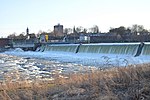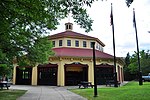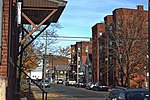Holyoke Canal System

The Holyoke Canal System is a system of power canals in Holyoke, Massachusetts. It is split into three canals based on elevation and distance from the inlet at the Holyoke Dam- the First Level Canal, Second Level Canal, and Third Level Canal. Constructed over a period between 1847 and 1892, the Canal System, along with the Dam, is recognized as a Historic Mechanical Engineering Landmark by the American Society of Mechanical Engineers for its use in the development of the Venturi meter by Clemens Herschel, the first means of measuring large-scale flows, and the McCormick-Holyoke Turbine by John B. McCormick, which doubled the efficiency of turbines to more than 80% in its time.
Excerpt from the Wikipedia article Holyoke Canal System (License: CC BY-SA 3.0, Authors, Images).Holyoke Canal System
Gatehouse Road, Holyoke
Geographical coordinates (GPS) Address Nearby Places Show on map
Geographical coordinates (GPS)
| Latitude | Longitude |
|---|---|
| N 42.2086 ° | E -72.6002 ° |
Address
Holyoke Water Power Company Boat Lock Station
Gatehouse Road 28
01040 Holyoke
Massachusetts, United States
Open on Google Maps










